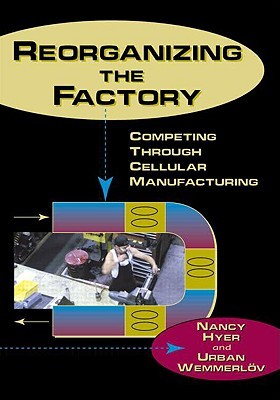
- We will send in 10–14 business days.
- Author: Nancy Hyer
- Publisher: Productivity Press
- Year: 2001
- Pages: 874
- ISBN-10: 1563272288
- ISBN-13: 9781563272288
- Format: 18.1 x 26.3 x 4.5 cm, hardcover
- Language: English
- SAVE -10% with code: EXTRA
Reviews
Description
Winner of the 2003 Shingo Prize!
Reorganizing work processes into cells has helped many organizations streamline operations, shorten lead times, increase quality, and lower costs. Cellular manufacturing is a powerful concept that is simple to understand; however, its ultimate success depends on deciding where cells fit into your organization, and then applying the know-how to design, implement and operate them.
Reorganizing the Factory presents a thoroughly researched and comprehensive life cycle approach to competing through cellular work organizations. It takes you from the basic cell concept and its benefits through the process of justifying, designing, implementing, operating, and improving this new type of work organization in offices and on the factory floor.
The book discusses many important technical dimensions, such as factory analysis, cell design, planning and control systems, and principles for lead time and inventory reduction. However, unique to the literature, it also covers in depth the numerous managerial issues that accompany organizing work into cells. In most implementations, performance measurement, compensation, education and training, employee involvement, and change management are critically important. These issues are often overlooked in the planning process, yet they can occupy more of the implementation time than do the technical aspects of cells.
Includes:
- Why do cells improve lead time, quality, and cost?
- Planning for cell implementation
- Justifying the move to cells, strategically and economically
- Designing efficient manufacturing and office cells
- Selecting and training cell employees
- Compensation system for cell employees
- Performance and cost measurement
- Planning and control of materials and capacity
- Managing the change to cells
- Problems in designing, implementing, and operating cells
- Improving and adapting existing cells
- Structured frameworks and checklists to help analysis and decision-making
- Numerous examples of cells in various industries
EXTRA 10 % discount with code: EXTRA
The promotion ends in 19d.22:57:35
The discount code is valid when purchasing from 10 €. Discounts do not stack.
- Author: Nancy Hyer
- Publisher: Productivity Press
- Year: 2001
- Pages: 874
- ISBN-10: 1563272288
- ISBN-13: 9781563272288
- Format: 18.1 x 26.3 x 4.5 cm, hardcover
- Language: English English
Winner of the 2003 Shingo Prize!
Reorganizing work processes into cells has helped many organizations streamline operations, shorten lead times, increase quality, and lower costs. Cellular manufacturing is a powerful concept that is simple to understand; however, its ultimate success depends on deciding where cells fit into your organization, and then applying the know-how to design, implement and operate them.
Reorganizing the Factory presents a thoroughly researched and comprehensive life cycle approach to competing through cellular work organizations. It takes you from the basic cell concept and its benefits through the process of justifying, designing, implementing, operating, and improving this new type of work organization in offices and on the factory floor.
The book discusses many important technical dimensions, such as factory analysis, cell design, planning and control systems, and principles for lead time and inventory reduction. However, unique to the literature, it also covers in depth the numerous managerial issues that accompany organizing work into cells. In most implementations, performance measurement, compensation, education and training, employee involvement, and change management are critically important. These issues are often overlooked in the planning process, yet they can occupy more of the implementation time than do the technical aspects of cells.
Includes:
- Why do cells improve lead time, quality, and cost?
- Planning for cell implementation
- Justifying the move to cells, strategically and economically
- Designing efficient manufacturing and office cells
- Selecting and training cell employees
- Compensation system for cell employees
- Performance and cost measurement
- Planning and control of materials and capacity
- Managing the change to cells
- Problems in designing, implementing, and operating cells
- Improving and adapting existing cells
- Structured frameworks and checklists to help analysis and decision-making
- Numerous examples of cells in various industries


Reviews